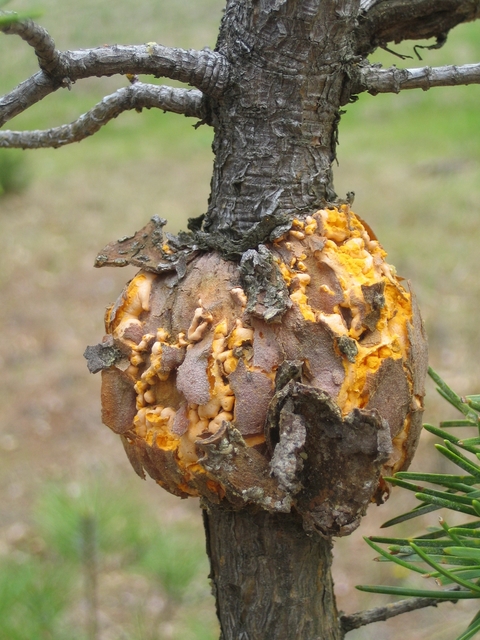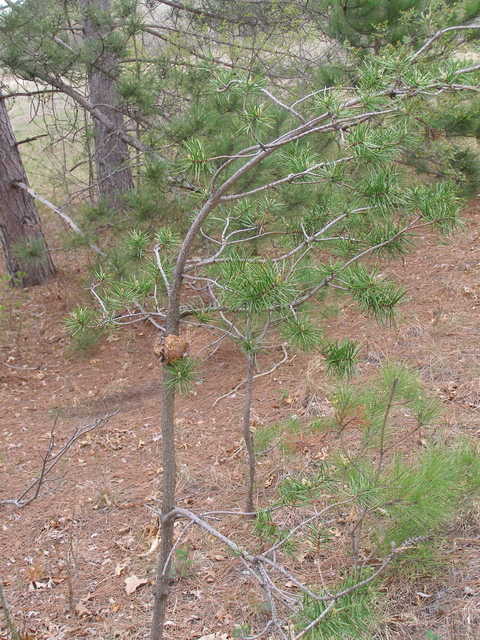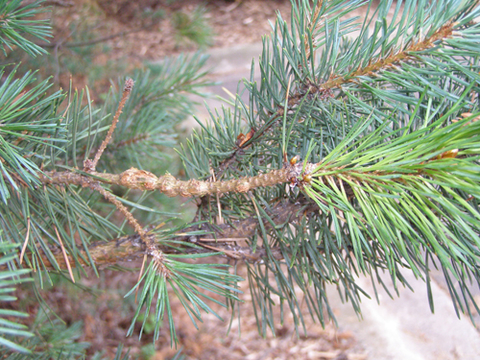Quick facts
-
Pine-oak and pine-pine gall rusts cause round to oblong, tumor-like galls to form on branches and trunks of 2-3 needle pine trees.
-
Galls cause poor branch growth, death of branches or death of young pine trees.
-
Well established trees may be disfigured but overall health is not affected.
-
These two diseases cannot be separated without microscopic examination.
How to identify pine-oak and pine-pine gall rusts
Galls (tumor like growths) form along the stems or branches of pine trees. These galls are:
Woody, round, oblong or irregularly shaped.
At first, galls are pea size (1/4 inch) but can grow to the size of a grapefruit (4 inches across).
On main stems, galls may reach 2-1/2 feet across.
In spring, bright yellow to orange spores form in cracks on the gall surface, making the galls very noticeable.
Sometimes, bark collars form on either end of the round or oblong gall where the branch and gall meet.
Needles may become yellow and stunted, and twig or branch growth may become stunted on the branch beyond a gall. Eventually the branch may die.
Infected oak leaves develop yellow spots or blotches, and brown hair-like structures on underside of oak leaves.
Trees affected by pine-oak gall rust
Pine-oak gall rust is a native fungal disease caused by Cronartium quercuum f.sp.banksianae. Two different host plants are required to complete the pathogen's life cycle. One plant from the pine family (Pinaceae) and the other from the oak family (Fagaceae).
Trees commonly affected by pine-oak gall rust include:
Pines
Austrian (P. nigra)
Jack pine (P. banksiana)
Mugo pine (P. mugo)
Red pine (P. resinosa)
Ponderosa pine (P. ponderosa)
Scots pine (P. sylvestris)
Oaks
Northern pin oak (Q. ellipsoidalis)
Bur oak (Q. macrocarpa)
Pin oak (Q. palustris)
Northern red oak (Q. rubra)
Trees affected by pine-pine gall rusts
Pine-pine gall rust is a native fungal disease caused by the fungus Peridermium harknessii (syn. Endocronartium harknessii), which affects only pine trees.
Trees commonly affected by pine-pine gall rust include:
Jack pine (P. banksiana)
Scots pine (P. sylvestris)
Where do pine gall rusts occur in Minnesota?
On Jack pine trees, pine-pine gall rust is most common in the northernmost counties of Minnesota including Cook, Lake, St. Louis, Koochiching, Lake of the Woods, Roseau, Itasca and Beltrami.
Pine-oak gall rust is most common in counties south of those listed above where red oaks are present.
How do pine gall rusts survive and spread?
Pine-oak gall rust life cycle
Pine-oak gall rust is caused by Cronartium quercuum f.sp.banksianae.
In spring or early summer, airborne spores are released from last year’s infected oak leaves.
These spores infect young needles and shoots of pine trees.
The fungus moves from the needles into branches or stems and stimulates the tree to produce more and unusually large cells. This causes a gall to form.
Water and nutrients don’t move easily through the gall. As a result, needles beyond the gall may turn yellow or brown and the branch eventually may die.
Infected branches become brittle and snap off from extreme winds or snow loads.
Galls are not usually visible for several months to a year after infection.
When the gall reaches maturity, the bark on the gall cracks and flakes off, releasing bright yellow-orange, powdery spores in spring.
These spores infect the leaves of nearby oak trees.
During the summer, clumps of powdery orange spores develop on the underside of oak leaves. These spores can only infect other oak leaves.
Later in the season, dark brown-to-black, hair like structures appear on the underside of leaves on the infected oak. These specialized spores, called telia, produce a different spore type that infects nearby pines the following spring.
Pine-pine gall rust life cycle
Pine-pine gall rust is caused by the fungus Peridermium harknessii (syn. Endocronartium harknessii)
The fungus survives from year to year in the living galls on pine trees.
Airborne, white-to-orange spores form on galls that are two years old or older.
In spring, these spores infect succulent, new growth of the same pine tree or neighboring pine trees.
Galls are not usually visible until later in the growing season or even until the following spring.
How to manage pine gall rusts
Inspect pine trees before you buy them. Purchase only trees with no branch swellings or galls.
Prune out galls:
Pruning out galls reduces the amount of spores produced that will infect nearby pine and oak trees.
Prune to remove infected pine branches with galls in late winter or early spring.
Galls do not need to be pruned if you choose to maintain the pyramidal shape of your pine tree.
There are no practical or recommended management practices to reduce pine oak gall rust on oak trees.
No pesticides are recommended on landscape trees.
Reviewed in 2024




